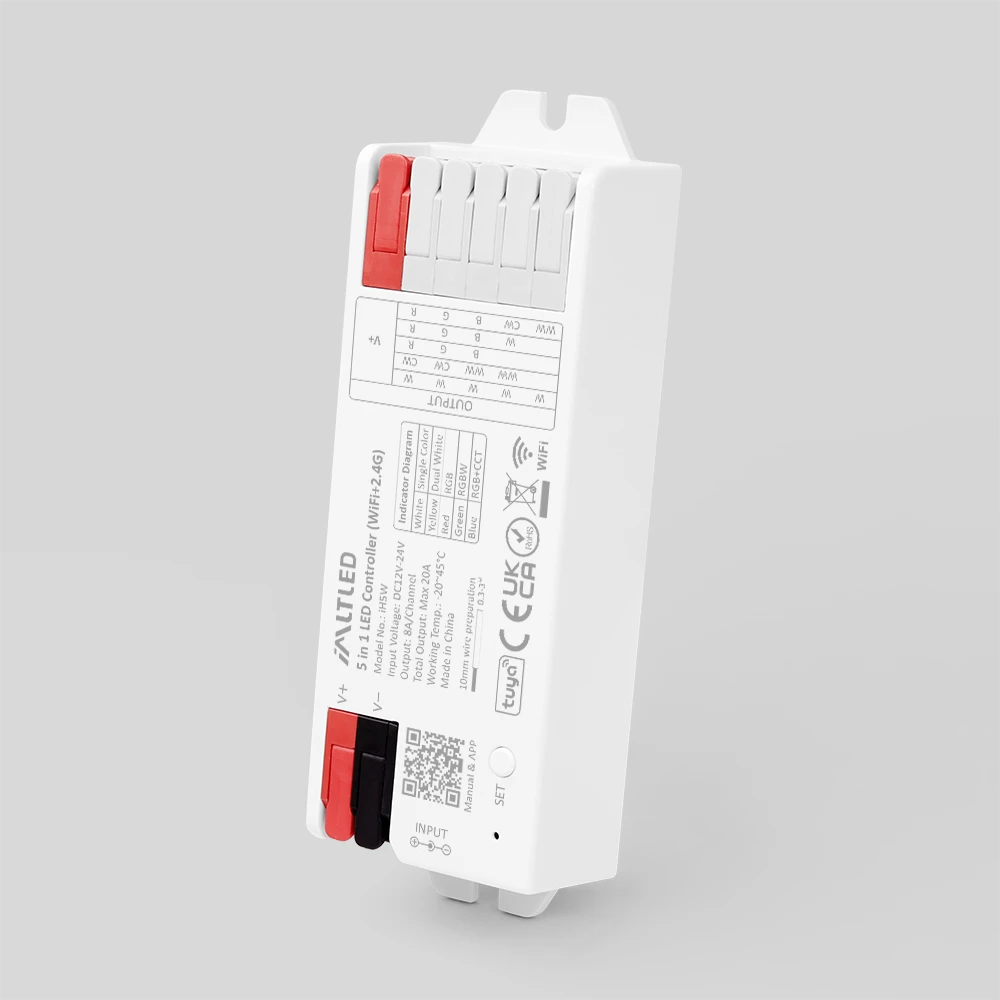What is an SMD LED Strip?
![]()
SMD (Surface Mounted Device) LED technology represents a type of LED (Light Emitting Diode) that utilizes surface-mounted technology to optimize space utilization.
Unlike traditional LEDs employing through-hole technology (THT), where LED leads are inserted into drilled holes in the PCB, SMD LEDs feature LED chips soldered directly onto the surface of a printed circuit board (PCB).
Key Features of SMD LED Strips:
- Compact Size: SMD LED Strips are engineered to be compact and lightweight, making them suitable for environments with limited space availability.
. High Efficiency: Renowned for their efficiency, SMD LED Strips consume less power while emitting brighter light output.
- Extended Lifespan: SMD LED Strips boast a longer lifespan compared to traditional LEDs, thanks to their lower power consumption and diminished heat generation.
- Enhanced Beam Angle: Through the clustering of multiple LED chips, SMD LED Strips achieve a wider beam angle, ensuring uniform light distribution.
- Cost-Effectiveness: SMD LED Strips typically offer a more cost-effective solution than traditional LEDs, attributed to their reduced power requirements and prolonged lifespan.
What is a COB LED Strip?
![]()
A COB (Chip on Board) LED strip represents a specialized form of LED strip leveraging chip-on-board technology to directly mount multiple LED chips onto a substrate, typically a printed circuit board (PCB).
This innovative approach allows for a higher density of LED chips, offering several notable advantages over conventional LED technologies such as SMD (Surface Mounted Device) LEDs.
Key Features of COB LED Strips:
- Compactness: COB LED strips boast a more compact design attributed to the diminutive size of the chip and the close arrangement of LED chips.
- High Intensity: COB LEDs emit light of higher intensity, particularly when viewed at close distances.
- Uniformity: COB LEDs provide superior uniformity of light, ensuring consistent illumination even at close working distances.
- Design Simplicity: With a simpler design comprising only one circuit and two contacts for the entire chip, COB LEDs offer streamlined functionality regardless of the number of diodes.
- Superior Thermal Performance: COB LEDs exhibit enhanced thermal performance, resulting in prolonged lifespan, heightened stability, and improved reliability.
Key Differences Between SMD and COB LED Strips
COB, or chip on board, entails the direct packaging of the chip onto the PCB. A COB LED strip encapsulates chips on a flexible board, representing a novel process technology. Its internal structure comprises PCB, phosphor, package chip, and gold wire.
SMD, or surface mount device, LED strip lights are among the most prevalent LEDs on the market. These LEDs feature chips permanently fused to a printed circuit board (PCB), renowned for their versatility. The internal structure encompasses PCB, printed circuit board, solder joints, brackets, phosphorescent packages, chips, and gold wires.
![]()
The COB chip emits light directly from the bottom, without any obstructions, enabling a light-emitting angle of up to 180 degrees.
In contrast, the patch LED strip includes a bracket, limiting its light-emitting angle to 120 degrees. The presence of the bracket influences the quality of light produced. Notably, the two technologies differ in the number of diodes, impacting brightness and light range.
COB LED strips emit uniform and glare-free light, whereas SMD LED strips produce glare, making them best suited as dot light sources. Flexibility distinguishes the COB LED strip, which is soft and capable of withstanding significant deformations, facilitating easy shaping as required. Moreover, the COB LED strip boasts easy installation in confined spaces, aided by strong adhesive properties.
In contrast, achieving spotless light with SMD LED strips necessitates compatibility with aluminum profiles. Conversely, COB LED strips can achieve this effect without aluminum profiles. If you’re seeking a lighting supplier for your project, consider the unique attributes of both technologies to meet your specific requirements.
![]()
Exploring the Advantages and Disadvantages of SMD LED Strips
SMD LED strips offer several benefits along with some limitations.
Advantages:
- Variety in Color Temperatures and Brightness Levels: SMD LED strips come in a wide range of color temperatures and brightness levels, catering to diverse applications.
- Compact Size: Designed to be compact and lightweight, SMD LEDs are ideal for environments with limited space.
- High Efficiency: Renowned for their efficiency, SMD LEDs consume less power while providing brighter light output.
- Longer Lifespan: SMD LEDs tend to last longer than traditional LEDs due to their lower power consumption and reduced heat generation.
- Flexibility: SMD LED strips, thanks to their smaller size, are more flexible, making them easier to install and bend around corners.
- Easy Installation: With adhesive backing and a simple design, SMD LED strips are easier to install.
Limitations:
- Point-Like Light Source Issues: SMD LED strips may produce a “dot effect” due to visible individual LED chips, which can be distracting in some applications.
- Heat Dissipation Issues: Without proper cooling, SMD LEDs may experience heat dissipation problems, impacting their lifespan.
- Lower Brightness and Color Rendering: Compared to COB LEDs, SMD LEDs may have lower brightness and color rendering capabilities.
- Limited Options for High-Density Applications: SMD LEDs may not be suitable for high-density applications requiring high brightness and uniform light distribution.
Exploring the Advantages and Disadvantages of COB LED Strips
Advantages of COB LED Strips:
- Smoother Illumination: COB LED strips provide seamless, dot-free lighting thanks to their high-density chip arrangement, enhancing aesthetics.
- Better cooling function: With excellent thermal management and a robust design, COB LED strips ensure long-term stability and reliability.
- Superior Flexibility: Highly flexible, COB LED strips are perfect for illuminating curved surfaces and tight corners.
- With a Wide Beam Angle: COB LED strips provide a wide emitting angle, approximately 180 degrees, ensuring optimal illumination and uniform light distribution.
- Anti-vulcanization and Anti-static Properties: Designed with anti-vulcanization and anti-static properties, COB LED strips boast enhanced durability and protection from environmental factors.
- Electrical Properties: COB LED strips feature low power consumption, high electrical efficiency, and low thermal resistance, offering an energy-efficient lighting solution.
Disadvantages of COB LED Strips:
- Higher Initial Costs: COB LED strips may be more expensive initially due to the advanced chip-on-board technology.
- Less Flexibility in Color Changing or Programmability: Compared to traditional LED strips, COB LED strips may offer less flexibility in color changing or programmability.
- Maintaining Color Consistency: Ensuring color consistency across different batches may pose a challenge for COB LED strips, despite rigorous quality control measures by reputable manufacturers.
- Luminous Efficiency and Power Considerations: COB LED strips may have lower luminous efficiency and require a higher voltage power supply, which may not always be readily available.
Applications of SMD and COB LED Strips
![]()
Both SMD and COB LED strips find versatile applications across residential, commercial, and specialized settings. Here’s a breakdown of scenarios where one may be preferred over the other:
Residential Applications:
SMD LED Strips:
- Under Cabinet Lighting: LED strip lights for kitchen cabinets due to flexibility and customizability.
- Accent Lighting: LED strip lights idea for accentuating architectural features or creating ambiance.
- Decorative Lighting: LED strip lights bedroom often used for decorative purposes like staircases or hallways.
COB LED Strips:
- High-Ceiling Areas: Better suited for high-ceiling areas requiring intense and uniform illumination.
- Task Lighting: Ideal for task-oriented applications like reading or cooking.
Commercial Applications:
SMD LED Strips:
- Retail Lighting: Commonly used in retail spaces for display, shelf, and ambient lighting.
- Office Lighting: LED Strip lights for ceiling suitable for task lighting and ambient lighting in office environments.
COB LED Strips:
- Signage and Backlighting: Perfect for signage and backlighting due to high brightness and uniformity.
- High-Intensity Lighting: Ideal for industrial settings requiring powerful and focused illumination.
Specialized Applications:
SMD LED Strips:
- Automotive Lighting: Flexible and cost-effective option for automotive interior lighting, such as LED strip lights for car.
- Photography and Film: Used for specific lighting effects or backlighting in photography and film.
COB LED Strips:
- Automotive Headlights: Employed in automotive headlights for superior brightness and focused output.
- Medical Lighting: Utilized in medical lighting applications like surgical lighting for intense and focused illumination.
Cost Considerations
When considering the cost-effectiveness of SMD versus COB LEDs, several factors come into play. Here’s a detailed analysis of cost considerations in both short-term and long-term scenarios:
Short-Term Cost Considerations:
Initial Purchase Price: SMD LEDs are typically less expensive upfront due to simpler design and lower material costs.
Installation Costs: SMD LEDs usually entail lower installation costs owing to their straightforward design and installation process.
Long-Term Cost Considerations:
- Energy Efficiency: COB LEDs offer higher energy efficiency, resulting in significant long-term savings on energy costs.
- Lifespan: COB LEDs boast a longer lifespan, leading to reduced replacement costs over time.
- Maintenance Costs: COB LEDs require less maintenance, translating to lower maintenance costs in the long run.
In conclusion, understanding the unique advantages and disadvantages of both SMD and COB LED strips is crucial in selecting the most suitable lighting solution for your specific needs. Whether you prioritize versatility, cost-effectiveness, or performance, weighing these factors carefully will ensure optimal illumination for your projects.
FAQ
What is the main difference between SMD and COB LED strips?
SMD LED strips are made up of individual LED chips mounted on a flexible circuit board, while COB LED strips have multiple LED chips directly mounted on a single substrate or circuit board, providing a more uniform and seamless light output.
Which type of LED strip is more energy-efficient?
COB LED strips are generally more energy-efficient than SMD LED strips due to their superior thermal management and higher lumens-per-watt ratio.
Can SMD LED strips be bent?
Yes, SMD LED strips are designed to be flexible and can be bent to a certain degree, making them suitable for various installation scenarios.
Are COB LED strips more expensive than SMD LED strips?
Initially, COB LED strips tend to be more expensive than SMD LED strips due to the advanced chip-on-board technology and higher material costs. However, COB LED strips may be more cost-effective in the long run due to their higher energy efficiency and longer lifespan.
Which type of LED strip is better for outdoor applications?
While both SMD and COB LED strips can be used for outdoor applications, COB LED strips are generally preferred due to their better heat dissipation, higher brightness, and more durable construction, making them more suitable for harsh outdoor environments.

